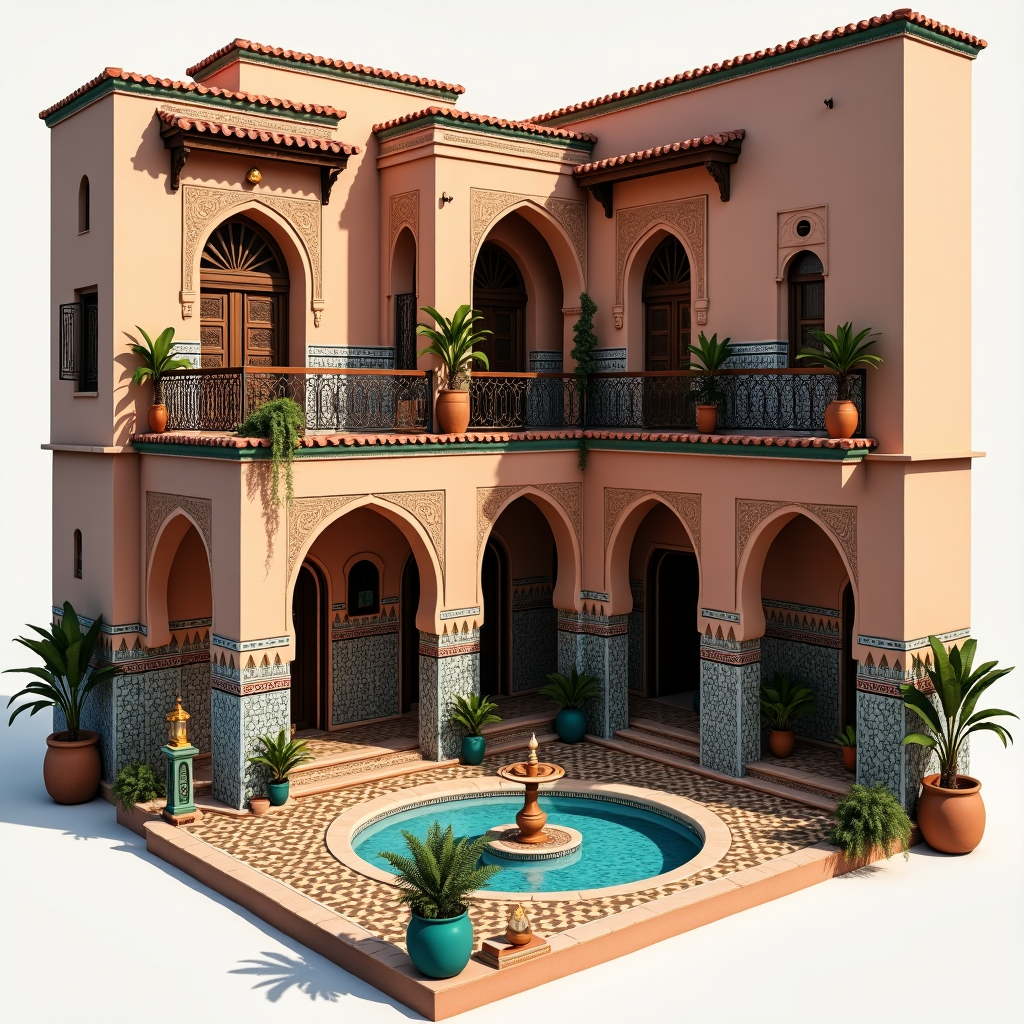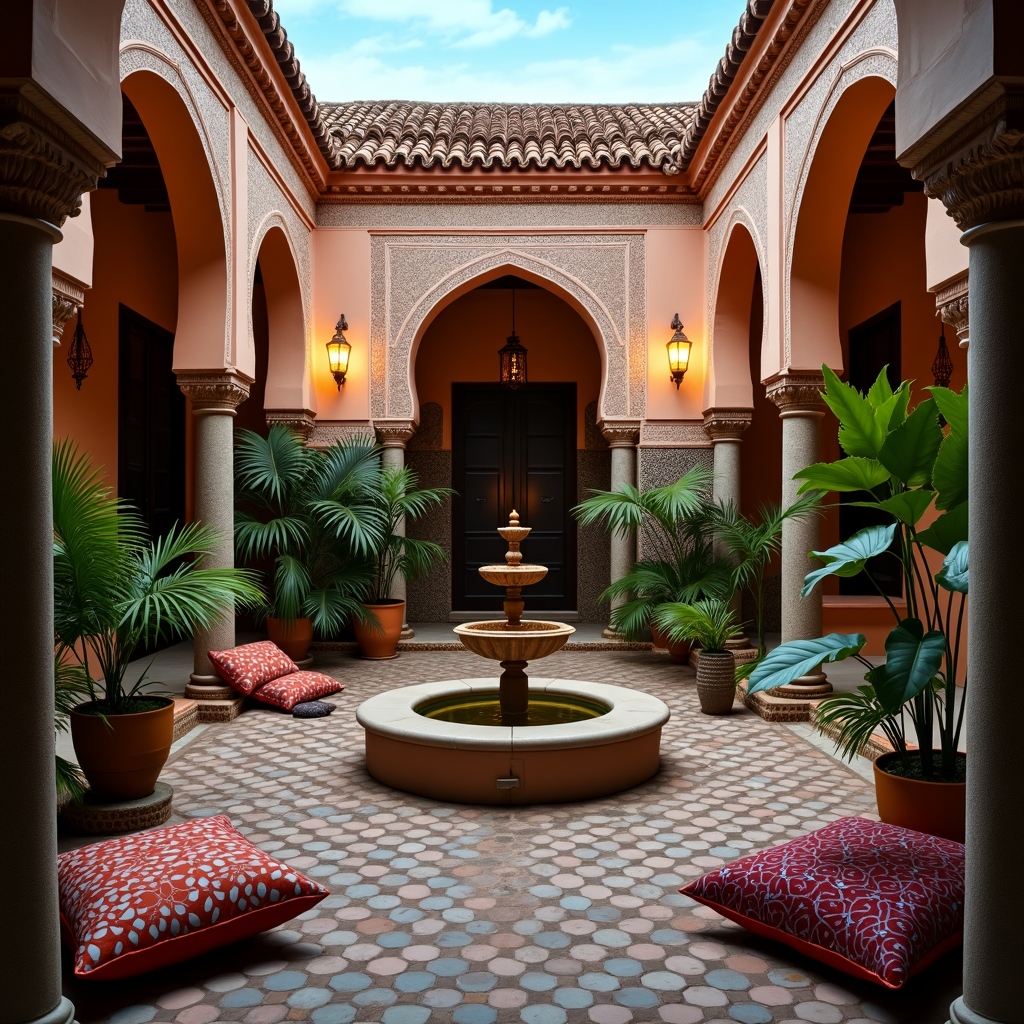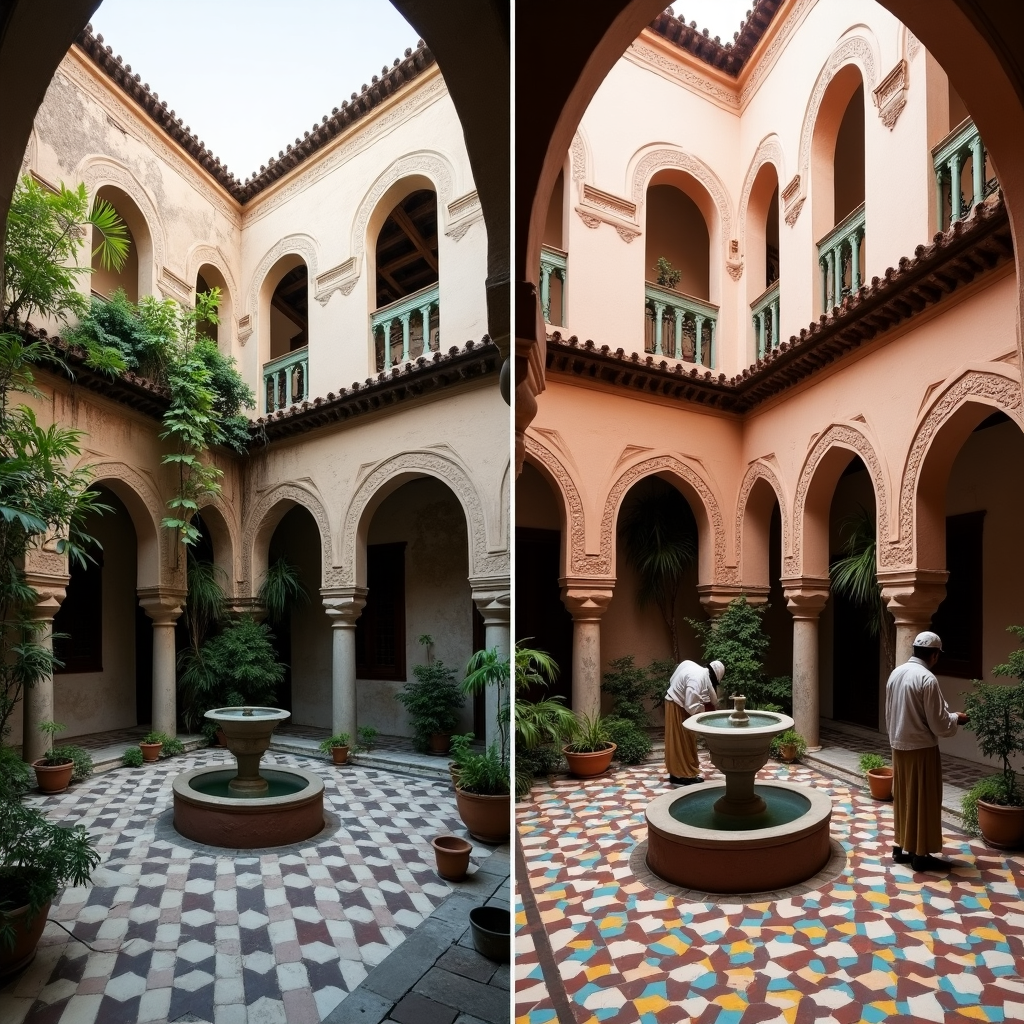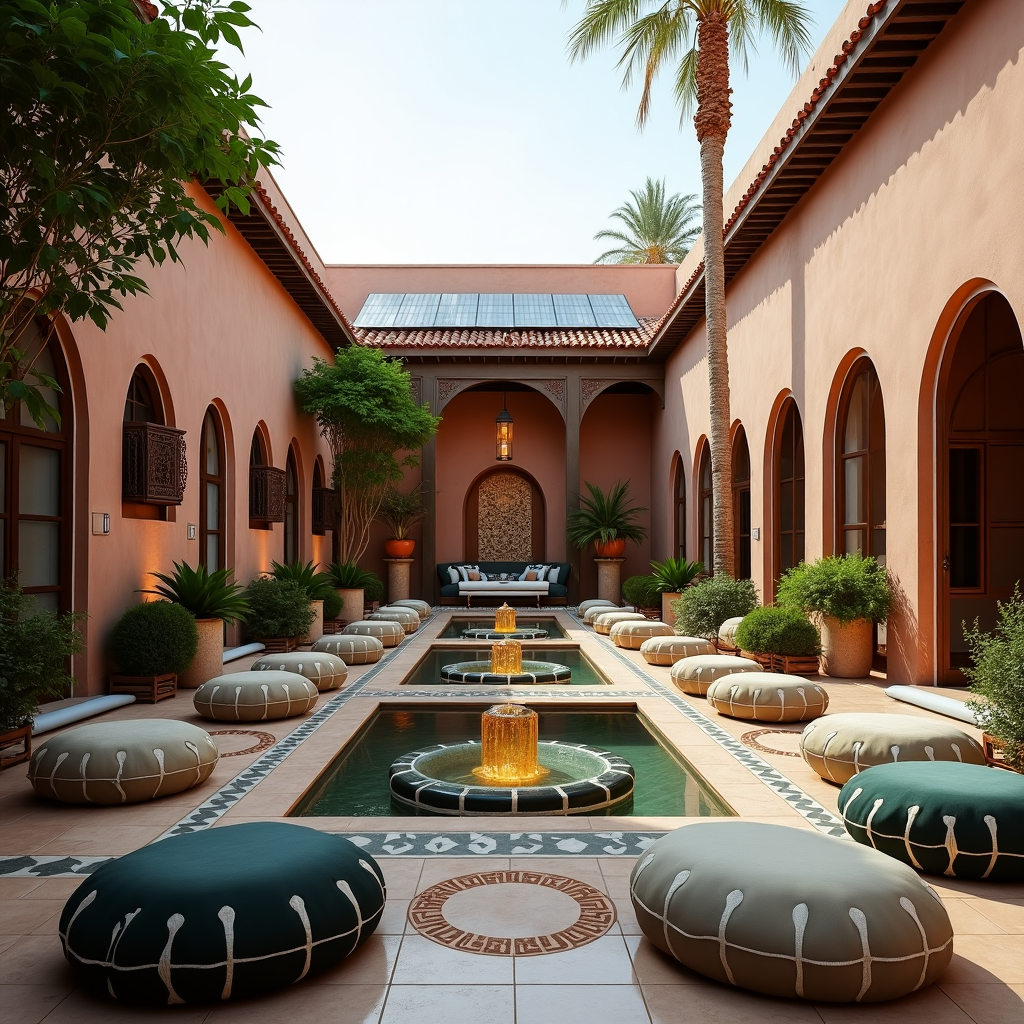
Welcome to the Enchanting World of Marrakech Riads, where history, culture, and luxury converge in the heart of Morocco’s Red City. These architectural gems are more than accommodations; they are portals to the vibrant heritage and artistry of Marrakech. In this guide, explore the allure of these traditional homes, the experiences they offer, and tips for finding your perfect riad stay in 2025
These architectural marvels offer more than just a place to rest your head – they provide an immersive experience into the heart and soul of Moroccan culture. Riads, with their intricate tilework, lush courtyard gardens, and ornate furnishings, stand as living testaments to the enduring legacy of Moroccan craftsmanship and design.
Let’s delve into the secrets that make Marrakech riads truly special and discover why they should be at the top of your travel bucket list. From the moment you step through their unassuming doors, you’ll be transported into a world where time seems to stand still, and the bustling medina fades away. Here, in these tranquil oases, you can experience the warmth of Moroccan hospitality while surrounded by the very essence of the country’s cultural identity.
Content:
The Essence of Marrakech Riads: A Glimpse into Moroccan Heritage

Marrakech riads are not merely accommodations; they are living testaments to Morocco’s rich cultural tapestry. These traditional houses, with their unassuming exterior walls concealing lush interior courtyards, embody the essence of Moroccan hospitality and architectural ingenuity. The word “riad” itself translates to “garden” in Arabic, hinting at the oasis of tranquility that awaits within.
The Anatomy of a Riad
At the heart of every riad lies a central courtyard, often adorned with fragrant orange or lemon trees, colorful mosaic tiles, and a soothing fountain. This open-air space serves as the home’s focal point, around which all other rooms are arranged. The design intentionally promotes natural ventilation and provides a cool retreat from the bustling medina outside.
A Symphony of Senses
Step into a riad, and you’ll be greeted by a sensory symphony. The gentle trickle of water from ornate fountains, the sweet scent of jasmine wafting through the air, and the intricate patterns of zellige tilework dancing across the walls – all combine to create an atmosphere of serenity and wonder. It’s a stark contrast to the vibrant chaos of Marrakech’s streets, offering guests a peaceful haven to rejuvenate and reflect.
Privacy and Intimacy
One of the defining features of riads is their emphasis on privacy. Unlike modern hotels with outward-facing windows, riads are designed to be inward-looking, with rooms opening onto the central courtyard. This layout ensures a sense of seclusion and intimacy, allowing guests to fully immerse themselves in the Moroccan way of life without the distractions of the outside world.
Trusted Partners:








Some of the links in this post are affiliate links, which means we may earn a small commission if you purchase them—at no extra cost to you. Thank you for your support!
The Historical Tapestry: Tracing the Origins of Marrakech Riads

To truly appreciate the magic of Marrakech riads, we must journey back in time to their origins. These architectural wonders have a rich history that spans centuries, evolving alongside the city itself.
The Birth of an Architectural Icon
The concept of the riad can be traced back to the 11th century, during the reign of the Almoravid dynasty. As Marrakech flourished as a center of trade and culture, wealthy merchants and nobles sought to create private sanctuaries within the bustling city. The riad design, with its emphasis on interior beauty and privacy, perfectly suited their needs.
Influences from Al-Andalus
The architectural style of Marrakech riads was heavily influenced by the Islamic gardens of Al-Andalus (modern-day Spain and Portugal). When the Moors were expelled from the Iberian Peninsula in the 15th century, many brought their architectural expertise to Morocco, infusing riads with elements of Andalusian design. This fusion gave birth to the distinctive Moroccan-Andalusian style that we see in many riads today.
From Decline to Renaissance
As Marrakech’s fortunes waned in the 19th and early 20th centuries, many riads fell into disrepair. However, the late 20th century saw a revival of interest in these historic homes. Visionaries, both local and foreign, began purchasing and restoring riads, transforming them into boutique hotels and guesthouses. This renaissance has not only preserved a vital part of Moroccan heritage but has also introduced a new generation of travelers to the magic of riad living.
Exclusive Insider Picks
- Stay in Style: Book a night at a riad with rooftop views, plunge pools, and traditional Moroccan breakfasts.
👉 Find Your Perfect Riad Stay - Cultural Experiences: Participate in cooking classes or hammam treatments during your stay.
👉 Book Riad Experiences - Historic Charm: Choose riads in the Medina for an authentic stay surrounded by historic sites.
👉 Explore Historic Riads Here
Architectural Marvels: The Unique Design Elements of Riads
Marrakech riads are a testament to the ingenuity of Moroccan craftsmen and the enduring appeal of traditional design principles. Let’s explore the key architectural elements that make these homes so distinctive and captivating.

The Courtyard: The Heart of the Home
The central courtyard is the defining feature of any riad. Typically rectangular or square, this open-air space serves multiple purposes:
- Natural cooling: The courtyard acts as a natural air-conditioning system, creating a microclimate that keeps the interior cool even during scorching summer days.
- Light source: The open roof allows natural light to flood the interior, illuminating the surrounding rooms.
- Social hub: The courtyard serves as a gathering place for family and friends, perfect for relaxation and entertainment.
Intricate Tilework: A Canvas of Color
Zellige, the intricate mosaic tilework that adorns many riads, is a hallmark of Moroccan craftsmanship. These hand-cut, geometric patterns are not only visually stunning but also carry deep symbolic meaning:
- Geometric patterns: Represent the infinite nature of Allah
- Floral motifs: Symbolize paradise and the beauty of nature
- Color choices: Each hue has its own significance (e.g., blue for spirituality, green for nature)
Carved Woodwork: A Testament to Artisanal Skill
The ornate wooden doors, window frames, and ceiling panels found in riads showcase the exceptional skill of Moroccan woodcarvers. Cedarwood is often used for its durability and aromatic properties. The intricate designs carved into these wooden elements often feature:
- Arabesque patterns
- Calligraphy
- Floral and geometric motifs
Tadelakt: The Smooth Operator
Tadelakt, a traditional Moroccan plaster technique, is used to create smooth, waterproof surfaces in riads. This lime-based plaster is applied by hand and polished with a stone, resulting in a lustrous finish that is both beautiful and functional. Tadelakt is commonly used in:
- Bathrooms
- Kitchen areas
- Decorative elements like arches and columns
The Rooftop Terrace: A Room with a View
Many riads feature a rooftop terrace, offering panoramic views of the medina and the Atlas Mountains beyond. These terraces serve as:
- A place for sunbathing and relaxation
- An outdoor dining area
- A vantage point for watching the sunset over the city
The Riad Experience: More Than Just a Place to Stay

Choosing to stay in a Marrakech riad offers travelers a unique and immersive experience that goes far beyond traditional hotel accommodations. Let’s explore what makes the riad experience so special and why it’s become a preferred choice for those seeking an authentic taste of Moroccan hospitality.
Personalized Service: A Home Away from Home
One of the hallmarks of riad stays is the intimate, personalized service. Unlike large hotels, riads typically have a limited number of rooms, allowing staff to provide attentive care to each guest. This personalized approach often includes:
- Warm welcomes with traditional Moroccan mint tea
- Tailored recommendations for local experiences and hidden gems
- Assistance with arranging tours, restaurant reservations, and transportation
Culinary Delights: A Taste of Morocco
Many riads offer in-house dining experiences that showcase the best of Moroccan cuisine. From hearty tagines to delicate pastries, guests can savor authentic flavors without leaving the comfort of their accommodation. Some riads even offer cooking classes, allowing visitors to learn the secrets of Moroccan cooking firsthand.
Cultural Immersion: Living Like a Local
Staying in a riad provides a unique opportunity to experience Moroccan culture from the inside out. Guests can:
- Observe daily life in the medina from their rooftop terrace
- Engage in conversations with riad owners and staff, gaining insights into local customs and traditions
- Participate in traditional activities like henna painting or tea ceremonies
Tranquility Amidst the Chaos
While the streets of Marrakech pulse with energy, riads offer a peaceful retreat from the hustle and bustle. The thick walls and inward-facing design create a serene oasis where guests can relax and recharge. Many riads also feature:
- Small plunge pools or jacuzzis for cooling off
- Spa services, including traditional hammam treatments
- Quiet reading nooks and lounging areas
A Photographer’s Paradise
With their stunning architecture and intricate details, riads provide endless opportunities for photography enthusiasts. From the play of light and shadow in the courtyard to the vibrant colors of Moroccan textiles, every corner offers a potential masterpiece.
Personalized Service: A Home Away from Home
- Attentive hosts welcome you with mint tea and cater to your preferences.
👉 Book Top-Rated Riad Stays with Personalized Service
Culinary Delights: A Taste of Morocco
- Many riads feature in-house chefs who prepare traditional Moroccan meals. Some even offer cooking classes to perfect your tagine-making skills.
👉 Book Culinary Experiences in Riads
Tranquility Amidst the Chaos
- Escape the bustling medina with serene courtyards and rooftop terraces. Many riads also feature spa services and pools.
👉 Find Riads with Spa Amenities
Choosing Your Perfect Riad: A Guide to Finding Your Moroccan Oasis

With hundreds of riads scattered throughout Marrakech, selecting the right one for your stay can seem daunting. Here’s a comprehensive guide to help you find the perfect riad that aligns with your preferences and budget.
Location
The first consideration when choosing a riad is its location within the medina. Each neighborhood has its own character and advantages:
- Mouassine: Central and bustling, close to major attractions
- Bab Doukkala: Quieter and more residential, with easy access to modern amenities
- Riad Laarous: Known for its artisan workshops and authentic atmosphere
- Kasbah: Historic area with a local feel, home to the royal palace
Consider your priorities – do you want to be in the heart of the action or prefer a more secluded setting?
Size and Amenities
Riads come in various sizes, from intimate three-room guesthouses to larger properties with up to 20 rooms. Think about what amenities are important to you:
- Swimming pool or plunge pool
- On-site restaurant
- Spa services
- Rooftop terrace
- Air conditioning (essential for summer visits)
Style and Decor
Marrakech riads showcase a wide range of design styles, from traditional Moroccan to contemporary fusion. Consider what aesthetic appeals to you:
- Classic Moroccan: Rich colors, intricate tilework, and ornate furnishings
- Minimalist: Clean lines, neutral colors, and a focus on natural materials
- Bohemian chic: Eclectic mix of Moroccan and global influences
- Modern luxury: High-end finishes with a nod to traditional elements
Budget Considerations
Riad prices can vary widely, from budget-friendly options to ultra-luxurious retreats. Determine your budget and look for riads that offer the best value within your price range. Keep in mind that prices often fluctuate based on season and demand.
Read Reviews and Ask Questions
Before booking, take the time to read reviews from previous guests. Pay attention to comments about:
- Cleanliness and maintenance
- Quality of service
- Noise levels (some riads can be affected by nearby mosques or busy streets)
- Accuracy of photos and descriptions
Don’t hesitate to reach out to the riad directly with any questions or special requests. Their responsiveness can be a good indicator of the level of service you can expect during your stay.
Exclusive Insider Picks
- Luxury Stays: Opt for riads like Royal Mansour for opulence and privacy.
👉 Discover Luxury Riad Stays - Boutique Charm: Seek out unique boutique riads that blend tradition with modern comfort.
👉 Explore Boutique Riads Here - Budget-Friendly Options: Enjoy an authentic experience without breaking the bank.
👉 Find Affordable Riads on Viator
The Art of Riad Restoration: Preserving Moroccan Heritage

The revival of Marrakech’s riads is a testament to the dedication of preservationists, architects, and visionaries who recognized the value of these historic homes. Let’s explore the intricate process of riad restoration and the challenges faced in bringing these architectural gems back to life.
Uncovering Hidden Treasures
Many riads purchased for restoration are in a state of disrepair, having been abandoned or neglected for decades. The restoration process often begins with a careful assessment of the property, uncovering hidden features such as:
- Original tilework beneath layers of paint
- Carved wooden elements obscured by later additions
- Ancient fountains or wells in overgrown courtyards
Balancing Authenticity and Modern Comfort
One of the biggest challenges in riad restoration is striking a balance between preserving historical authenticity and incorporating modern amenities. Restorers must find creative solutions to:
- Install plumbing and electrical systems without compromising the structure
- Incorporate air conditioning and heating while maintaining traditional aesthetics
- Upgrade bathrooms and kitchens to meet contemporary standards
Reviving Traditional Craftsmanship
Riad restoration has played a crucial role in preserving and revitalizing traditional Moroccan crafts. Artisans skilled in techniques such as:
- Zellige tilework
- Carved plasterwork (gebs)
- Wooden carpentry and carving
- Tadelakt plastering
are in high demand for these projects, ensuring that these ancient skills continue to be passed down to new generations.
Sustainable Restoration Practices
Many riad restorations now incorporate sustainable practices to minimize environmental impact and preserve resources. These may include:
- Using reclaimed materials from other historic buildings
- Implementing water-saving features like rainwater harvesting
- Installing solar panels for energy efficiency
- Choosing locally-sourced, eco-friendly materials
Legal and Cultural Considerations
Restoring a riad in Marrakech’s medina comes with unique legal and cultural challenges. Restorers must navigate:
- Complex ownership structures and property rights
- Strict regulations governing changes to historic buildings
- Cultural sensitivities regarding the preservation of traditional architecture
The Impact on Local Communities
The restoration of riads has had a significant impact on the surrounding neighborhoods. While it has brought economic benefits through increased tourism and job opportunities, it has also raised concerns about gentrification and the displacement of long-time residents. Responsible restoration projects strive to:
- Employ local workers and artisans
- Support community initiatives
- Maintain the authentic character of the neighborhood
Beyond Accommodation: The Cultural Significance of Riads

Marrakech riads are more than just beautiful places to stay; they play a vital role in preserving and showcasing Moroccan culture. Let’s explore the broader cultural significance of these historic homes and their impact on both locals and visitors.
Living Museums of Moroccan Craftsmanship
Each riad serves as a living museum, showcasing the best of Moroccan artisanship. From intricate zellige tilework to hand-carved cedar doors, riads offer visitors a firsthand look at centuries-old crafting techniques. This exposure helps to:
- Promote appreciation for traditional Moroccan arts
- Support local artisans and keep traditional crafts alive
- Inspire a new generation of designers and craftspeople
A Window into Moroccan Family Life
The layout and design of riads provide insight into traditional Moroccan family structures and social norms. Features such as:
- Separate men’s and women’s quarters
- The central courtyard as a gathering space
- The importance of privacy and seclusion
all reflect deeply-rooted cultural values and offer visitors a glimpse into Moroccan domestic life.
Bridging Cultural Divides
As more riads open their doors to international visitors, they serve as important cultural bridges. Guests have the opportunity to:
- Interact with Moroccan hosts and staff in an intimate setting
- Learn about local customs and traditions firsthand
- Gain a deeper understanding of Islamic architecture and symbolism
This cultural exchange fosters mutual understanding and respect between visitors and locals.
Preserving Architectural Heritage
The restoration and repurposing of riads have played a crucial role in preserving Marrakech’s architectural heritage. By giving these historic buildings new life as guesthouses and hotels, restorers have:
- Saved many structures from demolition or decay
- Maintained the traditional character of the medina
- Raised awareness about the importance of architectural conservation
Economic Impact on Local Communities
The riad tourism industry has had a significant economic impact on Marrakech, particularly in the old medina. Benefits include:
- Job creation for local residents
- Increased demand for traditional crafts and materials
- Revitalization of neighborhoods through improved infrastructure
However, it’s important to note that this growth has also brought challenges, such as rising property prices and concerns about overtourism.
Inspiring Modern Moroccan Design
The renewed interest in riads has inspired a revival of traditional Moroccan design elements in contemporary architecture and interior design. This influence can be seen in:
- Modern Moroccan homes incorporating riad-inspired features
- International hotels and resorts adopting Moroccan design elements
- A global appreciation for Moroccan-style decor and furnishings
The Future of Marrakech Riads: Adapting to Changing Times

As Marrakech continues to evolve as a global tourist destination, the role of riads is also changing. Let’s explore the challenges and opportunities facing these historic properties in the 21st century and how they are adapting to meet the needs of modern travelers while preserving their unique character.
Embracing Technology Without Losing Charm
One of the biggest challenges for riad owners is incorporating modern technology without compromising the traditional atmosphere. Innovative solutions include:
- Hidden smart home systems for climate control and lighting
- High-speed Wi-Fi networks disguised within traditional decor
- Digital concierge services that complement personal attention
Sustainability Initiatives
As environmental concerns become increasingly important to travelers, many riads are implementing sustainable practices:
- Solar panels for water heating and electricity generation
- Organic, locally-sourced ingredients in riad kitchens
- Water conservation measures, including greywater recycling
- Eco-friendly toiletries and linens
Diversifying Experiences
To stand out in a competitive market, riads are expanding their offerings beyond basic accommodation:
- Curated cultural experiences and workshops
- Wellness retreats featuring traditional Moroccan treatments
- Culinary programs showcasing local cuisine
- Partnerships with local artisans for unique shopping experiences
Balancing Authenticity and Luxury
As traveler expectations evolve, riads must find ways to offer modern luxuries while maintaining their authentic character. This might involve:
- Upgrading bathrooms and bedding to meet international standards
- Introducing spa facilities with traditional hammams
- Enhancing dining options with gourmet Moroccan cuisine
Adapting to Changing Travel Patterns
The global pandemic has forced riads to adapt to new travel realities. Some changes include:
- Enhanced cleaning and sanitization protocols
- Flexible booking policies
- Options for longer-term stays to cater to digital nomads
- Increased focus on outdoor spaces and private dining options
Preserving Community Connections
As the riad industry grows, there’s a renewed focus on maintaining strong ties with the local community:
- Employing and training local staff
- Supporting neighborhood initiatives and charities
- Offering authentic cultural experiences that benefit local artisans and performers
The Rise of Riad-Inspired New Builds
While traditional riads remain popular, there’s a growing trend of new, purpose-built properties that incorporate riad-style elements:
- Modern interpretations of the central courtyard design
- Use of traditional materials and craftsmanship in contemporary settings
- Fusion of Moroccan and international design influences
These new properties aim to offer the riad experience with added conveniences and larger scale operations.
Travel Essentials for Exploring Marrakech
Before embarking on your Marrakech adventure, ensure you’re well-prepared:
- Travel Insurance: Cover your trip for peace of mind during your Moroccan journey.
👉 Get Your Travel Insurance Now - Guided Tours: Enhance your riad stay with expert-led tours of Marrakech.
👉 Book Guided Tours of Marrakech Here - Pack Smart: Don’t forget essentials like sunblock, comfortable walking shoes, and a travel adapter.
👉 Shop Travel Essentials on Amazon - Transportation: Use private transfers for a stress-free arrival at your riad.
👉 Book Hassle-Free Transfers Here - Local Experiences: Add an authentic touch to your trip with food tours and cooking classes.
👉 Book Moroccan Culinary Classe
Top-Rated Riads in Marrakech
Here’s a curated list of some of the best-rated Riads in Marrakech, based on recent reviews and ratings:
Luxury Picks:
- Royal Mansour Marrakech: A haven of indulgence with private riads and underground tunnels for staff. 👉 Book Royal Mansour Here
- La Mamounia: Iconic for its lush gardens and Art Deco-meets-Moroccan elegance. 👉 Stay at La Mamounia
- Amanjena: Known for its serene ambiance and luxurious amenities. 👉 Experience Amanjena
Boutique Gems:
- El Fenn: Vibrant, art-filled interiors and a rooftop pool. 👉 Book Your Stay at El Fenn
- Riad Yasmine: Instagram-famous for its turquoise pool and cozy decor. 👉 Stay at Riad Yasmine
- Riad Kniza: Offers authentic Moroccan decor with personalized service. 👉 Stay at Riad Kniza
Budget-Friendly Stays:
- Riad Layla Rouge: Affordable with quirky Moroccan charm. 👉 Book Riad Layla Rouge Here
- Kif-Kif Marrakech: Perfect for social travelers and solo adventurers. 👉 Stay at Kif-Kif Marrakech
- Riad Dar Attajmil: Cozy and affordable with a homely feel. 👉 Book Riad Dar Attajmil Here
- Riad Massin: A budget-friendly option with a welcoming atmosphere. 👉 Stay at Riad Massin
These Riads offer a unique blend of traditional Moroccan architecture, modern amenities, and exceptional service, providing an authentic and luxurious experience in the heart of Marrakech.
References:
[1] 17 Best Riads in Marrakech | Hand-picked Guide 2024
[2] The 14 Best Riads in Marrakech, Morocco – Bon Traveler
[3] 20 Best Riads & luxury hotels in Marrakech in 2024 – TravelPlusStyle
Conclusion: The Timeless Allure of Marrakech Riads
The enchanting world of Marrakech riads is a testament to the city’s rich history and enduring charm. Whether you’re drawn to their stunning architecture, intimate hospitality, or cultural immersion, a stay in a riad promises an unforgettable Moroccan experience.
The riad experience goes beyond mere aesthetics. It’s about connecting with Moroccan culture on a deeper level – through the warmth of your hosts, the flavors of home-cooked meals, and the rhythms of daily life in the medina. It’s about waking up to the call to prayer echoing across the rooftops and falling asleep to the gentle splash of a courtyard fountain.





